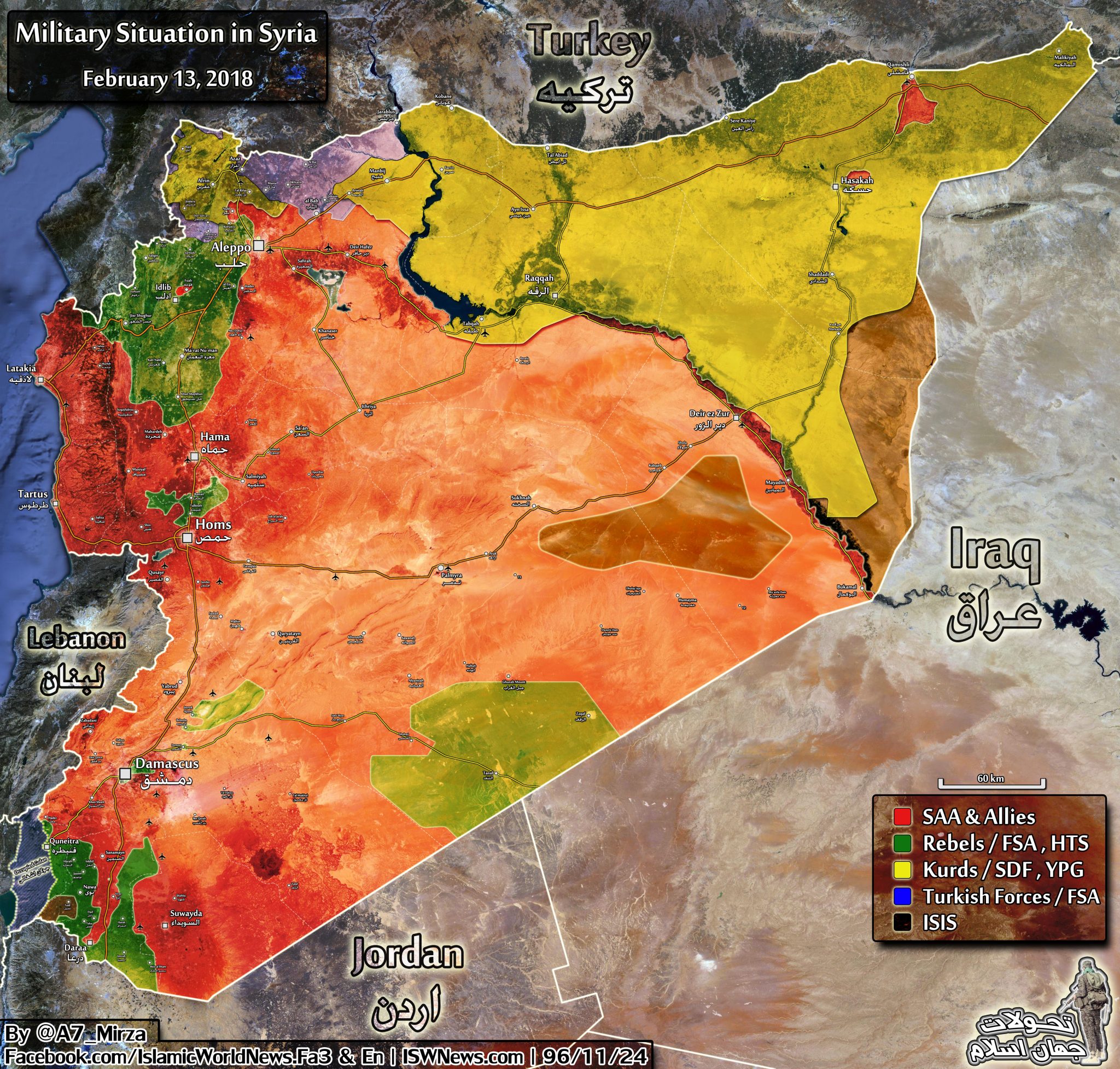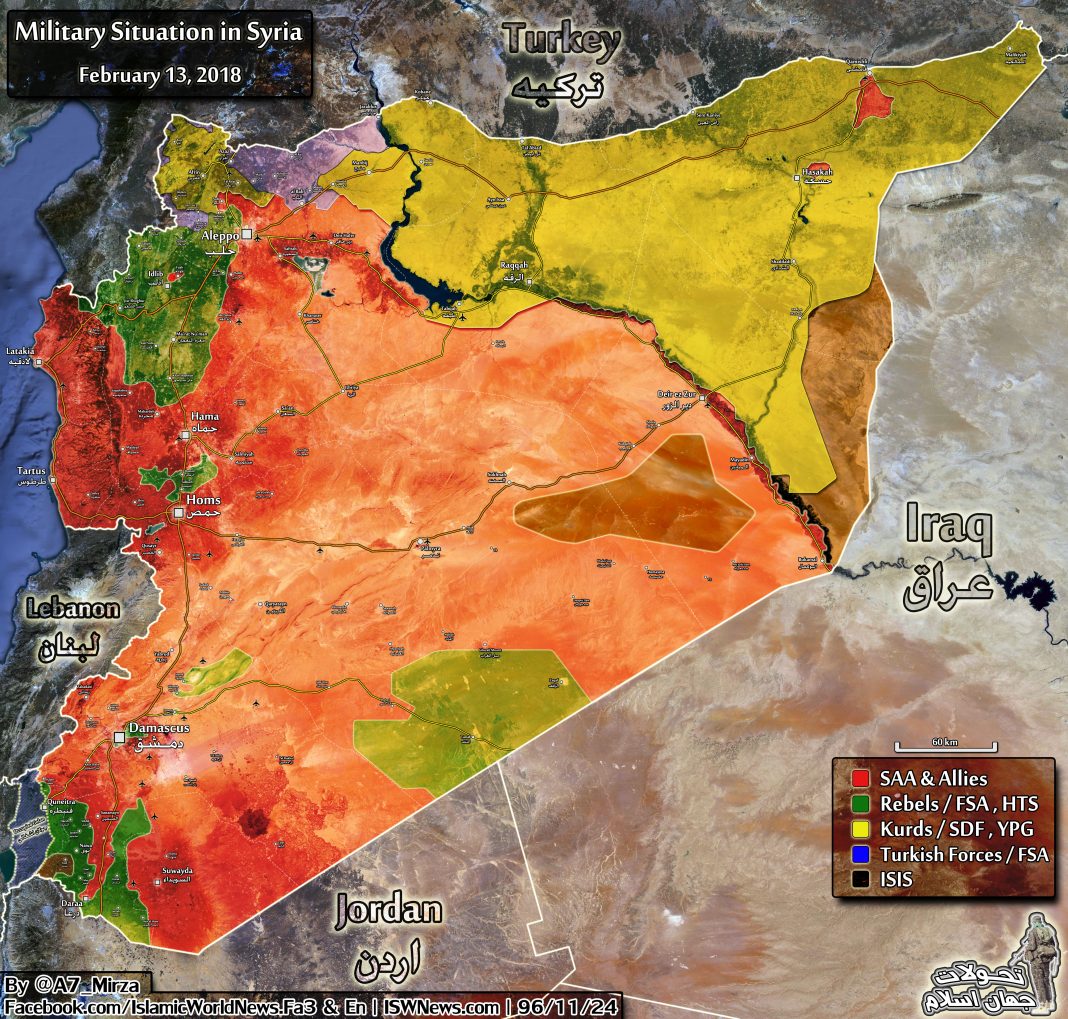With the end of the Abu Duhur offensive, and the Russian-Turkish de-escalation agreement sketched in Sochi, the Syrian Arab Army (SAA) is now prioritizing different targets. With Greater Idlib, the last major stronghold of Hay’at Tahrir al-Sham (HTS) severely reduced in size and ISIS technically neutralized with the exception of a few pockets and hideouts splintered across the huge Syrian Badiya, the Syrian Army will lay its eyes upon the long-neglected rebel-held pockets culminating in the following: northern Homs, Eastern Qalamoun, and Eastern Ghouta.

Map 1: Current ground position in Syria. Image Credit: @A7_Mirza (via twitter)
The Battle for Northern Homs:
The rebel-held bastion north of Homs stretches from the Homs-Tartous provincial boundary to the vicinity of the all-important supply route connecting Homs to the government stronghold of Salamiyah in Eastern Hama. Undoubtedly, the most important rebel-dominated strongholds in the insurgent bastion are the large towns of Rastan and Talbiseh. The aforementioned towns are positioned along the M-5 Highway connecting Damascus to Aleppo. Prior to the crisis, the trip between Hama and Homs would take around 30 minutes on a busy day. Today, thanks to the tumultuous route around the countryside and the countless security checkpoints along the way, the very same trip consumes roughly 8 hours. The logistic and economic boost from eradicating this nuisance serves a worthy and sufficient motivation to propel a massive operation to engage local rebel forces.
Since the outset of the Russian intervention in the fall of 2015, numerous Russian-sponsored attempts at pacifying the troublesome region failed to cover any measurable ground beyond the coordination of humanitarian aid shipments to the impoverished local populace.
In any case, the advantages of eliminating this pocket were obvious from the start of the conflict. In fact, Syrian forces had planned an extensive operation to uproot the jihadist rebels in the Homs countryside following the fall of Old Homs to loyalists in 2014, but more pressing concerns forced the SAA to allocate its manpower to the embattled front lines of the then government-controlled province of Idlib, the Latakian countryside, northern Hama, and the troublesome Jabal al-Zawiya region in the depth of the Ghab Plains. As such, any cessation of hostilities in Idlib province at the current stage of the Syrian conflict therefore presents a golden opportunity to initiate the long-awaited offensive in the heart of the Syrian countryside itself. The Tiger Forces and the 4th Armoured Division of the SAA will likely lead this battle which would resemble the Battle for Western Ghouta, albeit on a much larger scale. A successful conclusion to this conflict will also result in a significant manpower boost for the Syrian Government to use elsewhere since it will free up tens of thousands of primarily local National Defense Force (NDF) units guarding these arduous and long defense lines in addition to providing economic stimulus for what lies between southern and northern Syria.
The Battle for Eastern Qalamoun:
Once the theatre of rare Syrian Government-Rebel cooperation in the face of an overwhelming ISIS threat haunting the vast Syrian desert, the Eastern Qalamoun front lines have seen little-to-no action since the SAA’s conquest of the Buseiry mountain chain southwest of Palmyra in the Spring-Summer of 2017. Nevertheless, the potential for this strategic region to become a central hub linking American-trained and supplied rebels in Tanf to the besieged rebels of Eastern Ghouta and thereby re-ignite the Battle for Damascus is ample justification for the SAA’s High Command to designate this region a high priority target. This battle promises to be very similar in its operational nature to the Battle for the Barada Valley in which the capture of the dominant heights surrounding the main towns spurred a complete rebel surrender in the strategic region that provided the bulk of Damascus’s water supply. Similarly, government troops will place the bulk of their efforts to capture the Afa’I and Betra‘ mountains before rebels accept a reconciliation treaty that involves the deportation of HTS elements to Idlib via the now famous green buses.
The Battle for Eastern Ghouta:

Map 2: Denotes the Current Situation in Ghouta. Assad-Regime controlled territory is in Red. Assorted rebel group presence is in green. Image Credit: @Suriyakmaps (via twitter)
Of all the likely battles being discussed here, this will perhaps be the most complex. The western fronts of Eastern Ghouta present a putrid urban terrain littered with mines, booby traps, IED-laced building blocks, and ambush crossfires planted at every turn and corner. These unappealing features doomed previous loyalist offensives in Jobar and Ayn Tarma to premature failure. Though the rebels of Jaish al-Islam (JAI) have succeeded in setting up a standing line of defense in the eastern sector of the Ghouta bastion extending from Nashabiya all the way to Reyhan (roughly 12 km in length), the SAA’s Republican Guard and the 4th Division could theoretically cut through the farm area in a mechanized assault through sheer overwhelming fire power reducing the insurgent bulwark to just an urban strip extending from Ayn Tarma to Douma. A two-pronged assault at Mesraba and Harasta could then be initiated to permanently separate the rebels of JAI from their counterparts of Faylaq ar-Rahman (FAR) and HTS in Erbeen and Zamalka. However, within this small pocket that barely exceeds 150 sq. km in size, there is ca constantly evolving political landscape that complicates the dynamics of this Damascene battlefield, already ripe with countless entanglements. The Syrian government has found in JAI a faction willing to negotiate and potentially reconcile when subjected to the right amount of pressure. The government has in fact pushed JAI to assault their rivals within East Ghouta several times in an attempt to claim a monopoly of power in the area. This has resulted in bloody confrontations that have cost rebels hundreds of casualties in addition to a loss of popular support from the local population that suffers a grueling siege as local warlords hoard humanitarian aid and resources. Needless to say, these intra-rebel conflicts have failed to yield any notable shift in the balance of power.
Incapable of providing the helpless and waning JAI with air support against the Muslim Brotherhood-tied FAR as a result of political reasons and a lack of desire to subject JAI to a costly war of attrition on the eastern and southern fronts due to justified fears of a FAR and HTS takeover in East Ghouta, the SAA has been unfavorably coerced into launching brutish blunt assaults on the static western front lines under the wishful impression that a breakthrough would lead to an irreversible collapse of FAR and a broad conclusive peaceful resolution to the conflict in Eastern Ghouta. Nevertheless, recent reports about the deployment of the formidable Tiger Forces to the east Damascus theatre may prove to be the deciding factor in this anticipated confrontation.
Izat Charkatli is a regular contributor to AMN and a biomedical engineering student with some military experience
© Delhi Defence Review. Reproducing this content in full without permission is prohibited.
































